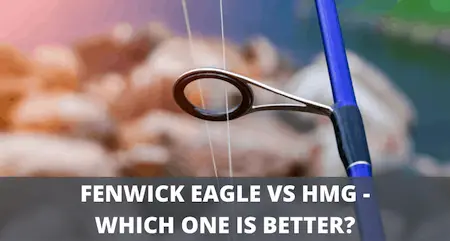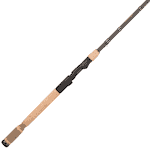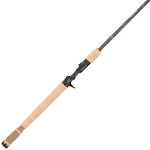Fenwick Eagle Vs HMG Rods – What Are The Differences, And Which One Should You Buy?
UPDATED 15 MAY 2023
by Robert Ceran
This article may contain affiliate links. If you make a purchase after clicking on a link we may earn a small commission at no extra cost to you.
If you’re in the market for a new Fenwick pole, you’ll need to decide whether the Eagle or HMG series is right for you.
For this article my team and I tested the most important features of the Fenwick Eagle vs HMG rods side by side, and will cover their main differences, to help you choose the best one for your purpose.

Fenwick HMG vs Eagle rods compared – what are the differences?
The table above summarizes the most important specs of both series that we tested.
Both rod series can be used for broadly similar purposes, and make excellent ultra light to medium power spinning poles, or medium to medium heavy power casting poles.
Before choosing one of these fishing rod types, you may want to refer to our in-depth comparison of spinning rod vs casting rod.
This is ideal for targeting species like crappie, bass, trout, and walleye with a wide range of different lures.
Now let’s look at their most important features in more detail, to see the main differences between them revealed by our testing.
The most important differences between Fenwick Eagle and HMG rods
Blank construction: This is the first category where there’s a major difference between the two.
The HMG series is made with Fenwick’s flagship technology of spiral carbon wrapping, which greatly enhances the strength & durability of the carbon blank while hardly adding to the weight.
In contrast, the Eagle series is built with a standard graphite blank, and our testing shows that this results in a much heavier pole, in order to guarantee enough durability and strength.
Length: The Eagle spinning series is available in a wider range of sizes, from 5’6” to 8’, while the HMG only covers 6’ to 7’6”. In this regard, the former offers more options of extra short or extra long sizes, which can be great for some applications.
You can refer to our fishing rod length chart to determine which length is best for your purposes.
Warranty: There’s a big difference between the two in this regard. The HMG comes with a limited lifetime warranty, while the Eagle only offers a 3 year warranty.
This difference reflects the higher quality material used for the former, which is built with their flagship carbon strengthening technology.
Weight: This is another area with a big difference between the two lineups. The HMG poles range from 3.00 oz. to 6.50 oz., while Eagle poles range from 3.70 to 11.30 oz. In other words, the heavier Eagle rods are almost twice as heavy as corresponding HMG models.
Line guides: All HMG models come with Fuji line guides, while the other series has stainless steel guides. Most anglers prefer the Fuji type line guides, which are also much lighter than stainless steel ones.
Handle material: While both series have cork handles, the HMG ones are made with solid premium cork, while the Eagle handle is made with reconstituted burled cork.
Action: In this category, both lineups are almost the same, although the HMG casting series offers several different variations of fast action, from moderate fast to extra fast.
For more details on how to choose the right action rod, check out our in-depth guide on fishing rod action.
Power: Both series are identical in this category. For more details on rod power, refer to our article fishing rod power rating explained.
Lure rating & line rating: Both series are identical in these categories.
Now that we’ve seen the main differences, let’s take a look at each of the lineups in full detail.
Fenwick Eagle spinning rod review


This pole is built with time tested graphite blank technology, resulting in a high quality rod at an affordable price.
As such, our testing revealed that it provides very high value for the money, and is great if you’re new to fishing, or want to get one or two secondary poles.
It also comes with 3 different handle sizes, depending on your preference.
Features:
- Burled cork handle
- Stainless steel guides
- Wide range of sizes and actions
- 3 year warranty
Fenwick HMG spinning rod review


This was the first all-graphite model on the market 47 years ago, and Fenwick has continuously improved the construction, an during our testing we found that this results in an extremely high quality pole built with their groundbreaking carbon fiber spiraling technology, which enhances blank strength while hardly adding to the weight.
Features:
- Premium cork handle
- Enhanced carbon strengthening technology
- Fuji reel guides
- Powerful, yet lightweight
Fenwick Eagle casting rod review


Similar to the spinning lineup, this series provides a high quality casting setup at an affordable price.
Overall, this is excellent value for money, and it also comes with 3 different types of handles, so you can choose the one you prefer.
Features:
- Burled cork handle
- Stainless steel guides
- Wide range of sizes and actions
- 3 year warranty
Fenwick HMG casting rod review


As for the spinning lineup, the casting series profits from the power and lightness of weight of the carbon fiber spiraling method.
Because of this blank construction technology, the heavy power fishing rods actually weigh half as much as models made with standard graphite technology.
Features:
- Premium cork handle
- Enhanced carbon strengthening technology
- Fuji reel guides
- Powerful, yet lightweight
Final remarks
In summary, the HMG series of spinning and casting poles are made with superior material and construction technology. This includes the blank strengthening technology, fuji reel guides, as well as a full cork handle.
Based on our testing, all of these differences add up to make the HMG a much lighter pole than the Eagle, while also delivering better performance.
These differences in quality explain the higher price of the HMG series, which is a great choice for a dedicated angler, especially if you’re looking for a new main rod.
However, the Eagle is also a great pole, and provides excellent value at a lower cost. It makes an excellent choice if you’re a beginner who wants to try out fishing, or if you’re looking to get a secondary pole.
If you’re specifically interested in fishing for bass, also take a look at our review on the best spinning rods for bass.
And if you’re into walleye fishing, check out our best walleye jigging rod review.
Gear and methods used for testing
For consistent testing results, we tested these rods under similar conditions on Lake Tarpon in 5 to 22 feet of water. We paired all of the rods with the same reel, a Shimano Stradic 2000HGFL for the spinning rods (spooled with 8 lb test Berkeley Trilene Fluorocarbon), or an Abu Garcia Revo X for the casting rods (spooled with 12 lb test Power Pro braid). We tested each rod with with crankbaits, jigs, and swimbaits in the 1/8 to 3/8 oz range.




